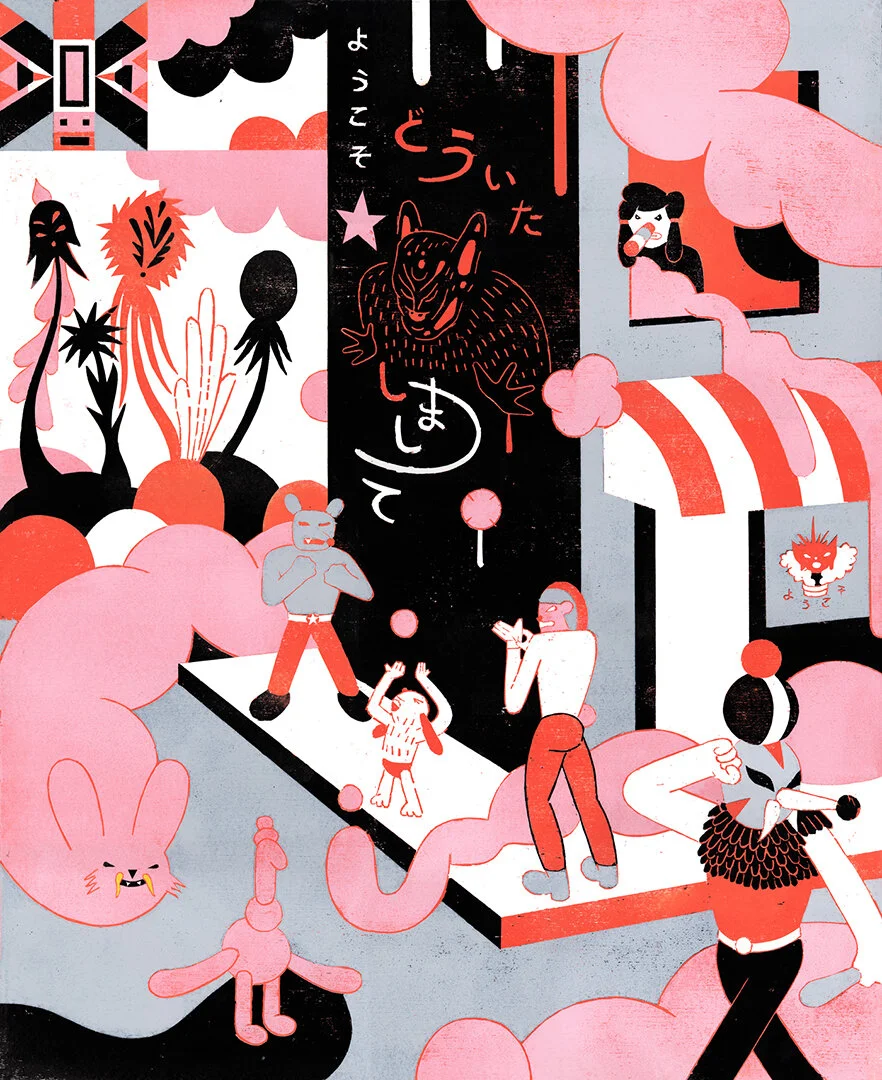An Omnific Conversation with Roman Klonek
Photo Credit: Marlène Meyer-Dunker
Roman Klonek is a Polish multi-disciplined artist and is an internationally known representative of contemporary print art. His work has been published and exhibited internationally in galleries such as Whitegrid Gallery, Pretty Portal, Feinkunst Krüger and elsewhere. He is the author of Woodcut Vibes. It was a pleasure to ask Roman about what he explores in his prints, how did he first navigate through the art world, and what he finds so appealing about the technique of woodcutting.
UZOMAH: What is so appealing to you about the technique of woodcutting?
ROMAN: There are several reasons. One is that I love to work with real material – besides computer work. And wood, in my case mostly poplar, is a wonderful and sympathetic material to work with. It looks and feels and smells good, and it can be cut very well.
Then of course it is the appearance of a woodcut printing. It looks a bit out of date. And that's what's particularly charming about it.
Considered art-historical – the typical woodcut has an aura of seriousness. So I have the impression of shifting my drawings into this aura. I like to counteract this with my motifs, which often come from the comic and cartoon world.
“French kisses” Woodcut, 37 x 48 cm, edition of 25 2020
U: Your prints explore half-human and half-animal creatures. How do you use that to display awkward situations that we all face?
R: You have to know, I scribble a lot in my sketchbook. at least one double-page every day. These scribbles are fleetingly snapped up impressions. Faces, figures, pictorial elements, indefinite shapes - and all of them mix together in a wild tangle of clouds. All in all, over the years there has been a huge jungle of picture elements that still have to become a coherent formation. This is where I find the building material for my picture ideas and I have to find out what belongs together. The creatures and also the situations develop naturally. When it comes to composition, it´s just important not to make the obvious connections – and also not the most absurd ones. My goal is to find this fine line in between.
U: Your use of blocks almost forms like a storyboard where each piece forms together and tells a story. How do you create that for the audience?
R: It’s a lack of interest to draw a continuous story. Because that would mean always having to draw the same character – and invent coherent storylines. But my interest lies precisely in picking up spontaneous hooks and always finding new characters. And this is where my sketchbook comes into play again. Single moments jump out of it. Freeze Frames if you will. I invite the viewer to imagine what happened shortly before and what happens shortly afterward.
“In your eyes” Woodcut, 42 x 50 cm, edition of 2019
U: Your use of colors is strong and distinctive. How do you select which you want and why?
R: Every extra color increases the complexity and working time of a print. So with every draft, I check how the picture can be realized with as few colors as possible. I think if there are so few – they must be bold, the red is always bright glaring red. I decide on a case-by-case basis which colors will be used.
U: How has art let you test your boundaries?
R: I'm interested in reaching my limits, yes, but more likely when I'm on vacation in nature, for example.
In connection with my art, it is rather involuntary - for example, when I have to print until late at night, overtired because I am dissatisfied with something or the edition has to be finished.
“Rampant blubber” Woodcut, 85,2 x 69,4 cm, edition of 8 2018
U: Where do you see the art of graphic design in ten years in terms of technology?
R: Ha, you ask someone who has dedicated himself to a technology that is centuries old. But of course, I'm also interested in the development of technologies. In the culture and entertainment sector, we will certainly experience things that trigger us even faster than today, especially in the field of virtual reality. We will probably experience effects that will make us addicted. Boredom will no longer have a chance. The graphic design of these new worlds will probably also go towards 3D.
U: How do you seek out opportunities?
R: I try to be open to creative influences. This requires a certain amount of relaxation. Running and cycling clear my head – but also carving. A clear head is the best device to receive interesting thoughts.
U: When you first started did you find it hard to navigate the art world?
“Last day of a summer” Woodcut, 50 x 60 cm, edition of 8 2019
R: I started with good luck and a little coincidentally. Immediately after my studies, I and my friends founded a mixture of ateliers and galleries here in Düsseldorf.
So we got the chance to exhibit in our own gallery. Often accompanied by live music, readings, and other opportunities for performances by people we found interesting. There were actually a lot of people joining us. It was a funny entry into the art world. Because we soon became known to a certain clientele in the city. Even superregional. So it came about those other galleries invited us to exhibitions. And so on .. natural widening effects.
For more information about Roman’s work please visit his site. Also, connect via Facebook, Instagram, and Behance with Roman.




